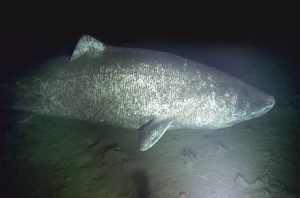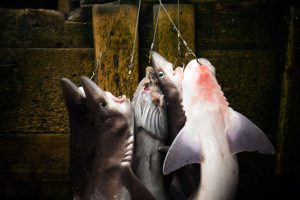
People & Culture
On thin ice: Who “owns” the Arctic?
As the climate heats up, so do talks over land ownership in the Arctic. What does Canadian Arctic Sovereignty look like as the ice melts?
- 4353 words
- 18 minutes
This article is over 5 years old and may contain outdated information.
Science & Tech

For the past two summers, postdoctoral fellow and shark expert Steve Kessel has flown north from his research lab at Ontario’s University of Windsor to the icy waters of Resolute Bay, Nunavut, to study one of the world’s strangest and least-understood animals: the Greenland shark.
Growing up to six metres long and weighing 1,000 kilograms-plus, the blunt-nosed, gnarly skinned Greenland is among the largest of all sharks. It may also live the longest: growing as little as a half-centimetre per year, Greenland sharks probably don’t reach maturity for 100 years and could live for 200 years or more, suspect scientists.
If those estimates are accurate, it could spell trouble for the species in the future, as global warming opens its home waters in the Arctic to increased commercial fishing. “If they are in fact extremely slow-growing, and extremely long-lived, that would make them very susceptible to fishing pressure,” Kessel says. “They are already a huge bycatch species off Baffin Island, so the potential for very rapid population declines is huge.”
That’s one of the reasons Kessel’s research, which involves live-capturing Greenland sharks, then tracking their movements with acoustic and satellite tags, is so important. “We want to get a feel for where the populations are, as well as their movements and survival rates once they’ve been netted and released as bycatch,” he says.
He’s already learned the Greenland shark isn’t exclusively a deepwater species, as it was previously classified. “We’re looking at occurrences of Greenland sharks in extremely shallow water, where they come up and almost beach themselves trying to get at marine mammal carcasses killed by Inuit hunters,” he says.
Reducing bycatch and other ecological damage is part of using resources responsibly. Understanding the Greenland shark’s place in the Arctic’s ecological puzzle builds knowledge that will help do just that.


Are you passionate about Canadian geography?
You can support Canadian Geographic in 3 ways:

People & Culture
As the climate heats up, so do talks over land ownership in the Arctic. What does Canadian Arctic Sovereignty look like as the ice melts?

Wildlife
Using cameras baited with squid, researchers were able to gather information about these ancient Arctic fish without taking any out of the water

Wildlife
Can British Columbia’s spiny dogfish make the grade as the world’s first “sustainable” shark fishery?

Environment
The uncertainty and change that's currently disrupting the region dominated the annual meeting's agenda